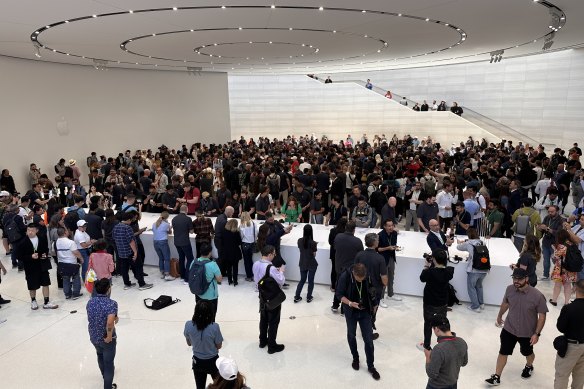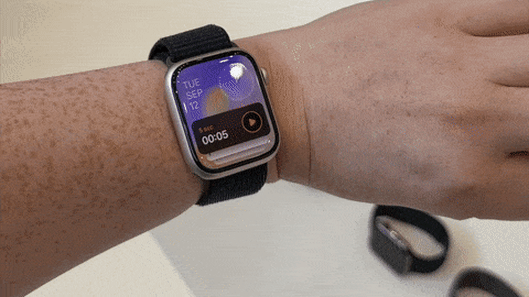
Apple’s process for introducing its new products to the media, and therefore to the world, which remains largely unique, was once described as a reality distortion field. That is to say that its pre-reveal secrecy, celebratory introduction, fanciful terminology and aura of mad excitement is designed to remove the items from their context as expensive consumer items, generating giddy hype from those in attendance.
However, and you’re free to doubt me on this given my exposure to the field, I don’t think the events needs to be judged with that level of cynicism.

Under the glass top of the theatre was a large area with not quite enough demonstration units to prevent some shoving and jostling.Credit: Tim Biggs
Exercises in marketing and PR though these events may be, it’s impossible to deny an element of real joy while you’re there, radiating from the Apple employees at all levels who’ve been working on the devices for years, from the creative invitees for whom new device features mean real impacts on their livelihoods, and even from media who are in their element explaining the news to breakfast TV, radio audiences and social media users in dozens of languages.
The air buzzed as an Apple executive enthused about the technology behind the iPhone’s first 5x optical zoom lens, even if they didn’t indulge in use of the marketing term tetraprism. A videographer’s mind was blown as they imagined capturing incredibly high-resolution and high-frame-rate video directly to an external card over USB-C. Debates were held over the best new iPhone colours, before everyone came to their senses and realised they were green and natural titanium.
Loading
Yet, it’s equally clear that Apple doesn’t wield a magic spell that makes everyone fall in love with their latest glass and metal boxes. The place was full of sceptics and eyebrow-raisers, and the news as always was met with as much dismissal and doubt by the public at large as by excitement and impulsive pre-orders.
That, too, is part of the benefit of being there in person: you don’t have to take everything in the presentation at face value. Apple’s policy on almost all of its closed-door media briefings is that they’re strictly “on background”, meaning I can’t tell you who I met or exactly what they said, I can just use the content of those meetings to inform my understanding of the products. Which is frustrating on one hand, but on the other means the experts can be completely candid. And it also means that when the presentation shows a new Apple Watch feature that lets you tap your fingers instead of touching the screen, you can find out pretty quickly if it works.

Double tapping from the home screen scrolls through your “smart stack” of widgets.Credit: Tim Biggs
The presentation said you’d use this feature “every day” (which was a bit of a theme this year), and after testing it I can say it works consistently, since you need to raise your wrist to wake the screen before you do it. That said, I did see Apple employees on two separate occasions trigger it accidentally with their hand resting on a desk, but the result was similar to when you inadvertently summon Siri; nothing much happens. I learnt that it’s much easier to double tap when I get a text and speak my reply out loud, as opposed to trying to type on the watch, and that it’s extremely satisfying to hang up on someone by tapping.
So yes, you might use it every day, if you buy the new watch. I also learnt that the reason double tap is not coming to older watches is that it needs the machine learning speed of the new S7 chip to collate readings from several sensors at once, and reliably detect the gesture.
Elsewhere, I saw the fruits of Apple’s other new chip, the A17 Pro, as I watched an iPhone 15 Pro Max play Resident Evil Village in what to my eyes was a decent resolution and a solid 30 frames a second, the kind of feat you’d usually need a console or desktop PC for. And yet, a cool reception to some of my questions about games made me wonder whether the capability was a byproduct of development on desktop class Apple Silicon, rather than an earnest push to make Mac-level gaming portable.
Loading
Apple Park itself is a beautiful and expensive-looking campus, though I didn’t get to see much of the huge ring building except for the wellness and fitness centres. Everything else – work stations, a soccer field, meeting rooms, someone’s inflatable flamingo – whizzed by in a flash as I clung to the back of a golf cart. Which reminded me of another aspect of Apple on display: it’s secrecy.
Somewhere in there, or in other similarly shiny buildings, are the people who decide the new iPhone colours, who invent the camera technology, decide the policy on data privacy versus proactively spotting abusers, and who research how to turn breakthroughs into features you’ll use every day. Many of them undoubtedly working away in secret, until we can get another peek behind the curtain next year.
The author travelled to California as a guest of Apple.
Get news and reviews on technology, gadgets and gaming in our Technology newsletter every Friday. Sign up here.









 Add Category
Add Category